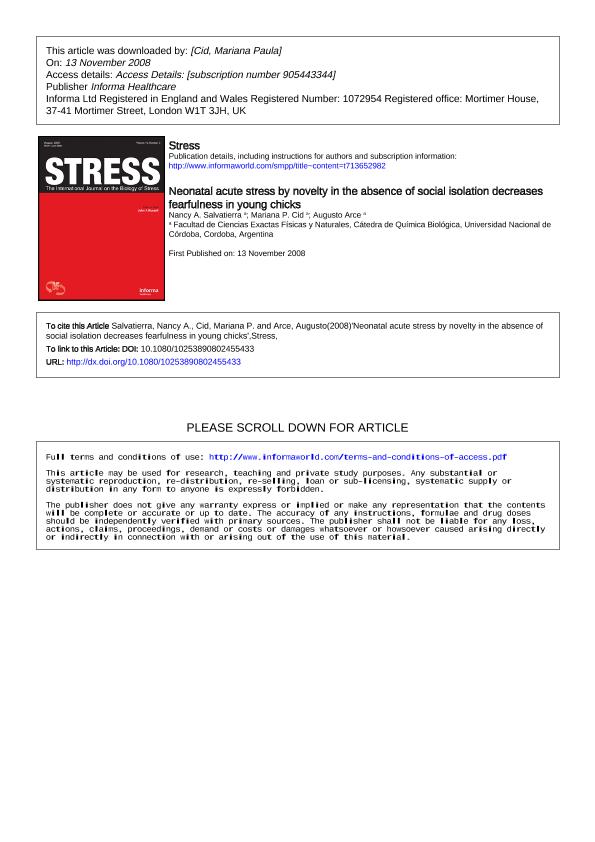Artículo
Neonatal acute stress by novelty in the absence of social isolation decreases fearfulness in young chicks
Fecha de publicación:
13/11/2008
Editorial:
Taylor & Francis Ltd
Revista:
Stress
ISSN:
1025-3890
e-ISSN:
1607-8888
Idioma:
Inglés
Tipo de recurso:
Artículo publicado
Clasificación temática:
Resumen
Two hours after hatching (Day 0), groups of chicks from both sexes were housed either individually (IND) or socially in pairs (SOC) for 24 h. On Day 1, for each of the two conditions, half of the chicks were individually exposed to early novelty for 10 min, which comprised being placed in a novel-cage with small pebbles glued to the floor. The other half (controls) remained in the home-cage (IND-C and SOC-C). Thus, the IND-N group was exposed to early novelty, and the SOC-NI group was exposed to early novelty and social isolation. Subsequently, all groups were mixed and socially reared until reaching 15 days of age. At this time, chicks were exposed to open field (OF) and tonic immobility (TI) tests. The IND-N group showed a shorter latency to ambulate in the OF test, shorter immobility duration in the TI test, a reduced plasma corticosterone concentration and increased flunitrazepam sensitive-GABAA receptor basal forebrain density compared with other groups, indicating that a neonatal novelty induced lower fearfulness in young chicks. In contrast, the effect of neonatal novelty was abolished by a simultaneous effect of social isolation in the SOC-NI group. Thus, early post-hatch life events such as early novelty could improve a bird's later ability to cope with new stressful events. In addition, it is possible that both novelty and social isolation act on different neurobiological processes.
Archivos asociados
Licencia
Identificadores
Colecciones
Articulos(CCT - CORDOBA)
Articulos de CTRO.CIENTIFICO TECNOL.CONICET - CORDOBA
Articulos de CTRO.CIENTIFICO TECNOL.CONICET - CORDOBA
Articulos(IIBYT)
Articulos de INSTITUTO DE INVESTIGACIONES BIOLOGICAS Y TECNOLOGICAS
Articulos de INSTITUTO DE INVESTIGACIONES BIOLOGICAS Y TECNOLOGICAS
Citación
Salvatierra, Nancy Alicia; Cid, Mariana Paula; Arce, Augusto; Neonatal acute stress by novelty in the absence of social isolation decreases fearfulness in young chicks; Taylor & Francis Ltd; Stress; 12; 4; 13-11-2008; 328-335
Compartir
Altmétricas




